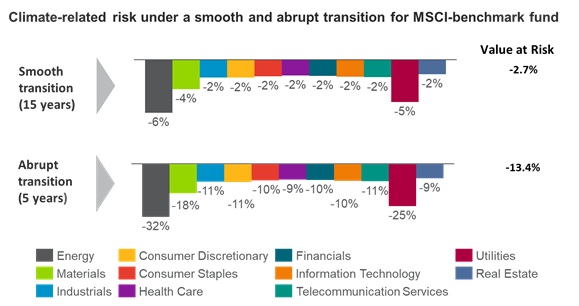- Paris Agreement
- Climate Targets
- Energy Climate Policy
Delaying Climate Actions Results in Significant Transitional Risks

Climate change poses a severe risk to businesses and the global economy. Financial institutions already experience the effects of climate-related risks; in 2017, climate-related disasters caused $306 billion in total damage in the US. At the beginning of 2018, the World Economic Forum rated extreme weather events, and the failure of society to mitigate and adapt to climate change mitigation was among the top five most impactful risks. Additionally, banking and pension authorities in England and the Netherlands have issued warnings on the dangers of climate change to investments. With the recommendations of the Financial Stability Board’s Taskforce on Climate-related Financial Disclosure, more and more pressure is being placed on financial institutions to assess, disclose, and manage their climate-related exposure and risks.
Based on a scenario analysis and risks assessments for financial institutions, Ecofys, a Guidehouse company, assessed the potential effects of delayed climate actions on the magnitude of these climate-related risks.
An Abrupt Transition Is More Likely If Policies Don’t Become More Strict
Following a 3-year period of no global growth, energy-related CO2 emissions grew by 1.4% in 2017, according to the International Energy Agency. This evidences that current climate actions are not enough.
Ecofys and Guidehouse, Climate Analytics, and NewClimate Institute recently concluded in their Climate Action Tracker that, while some progress has been made, most governments’ policies are not on track to meet their Paris Agreement commitments. Many of these policies are far from sufficient to limit warming to below 2°C, as set down by the Paris Agreement. The Climate Action Tracker asserts that there is an urgent need for governments to scale up their policies and targets so they are more in line with the Paris Agreement.
Despite this, significant changes in government policy are not expected in the short-term. By delaying climate actions now, stricter policies are required for the future (like a rapid phaseout of coal power production), leading to a more abrupt transition. The transition period toward 2030 (the year often used in climate-related risk assessment) could move from a smooth transition over 15 years to an abrupt transition in 5 years in order to reduce emissions rapidly.
An Abrupt Transition Results in Significant Climate-Related Risks
It is important for financial institutions to understand the difference in financial risk between an abrupt and a smooth transition. To quantify the financial effects of the transition on a financial portfolio, Ecofys and Guidehouse developed a detailed model to forecast the financial effects of the transition on the valuation of a company.
The team used this model to help Actiam, a leading Dutch investor (with approximately 55 billion in assets under management) better understand the different financial risks of a smooth versus an abrupt transition. Modeling the climate-related risks of Actiam’s funds under a smooth (15 years) and an abrupt transition (5 years) revealed that the risk increases significantly and surpasses stress levels. The figure below shows the outcome for the MSCI-benchmark fund.

(Source: Ecofys, a Guidehouse Company)
To understand, predict, and reduce the magnitude of climate-related financial risks, Ecofys and Guidehouse recommend that financial institutions track the speed of the transition with a set of signposts tailored toward their portfolios.